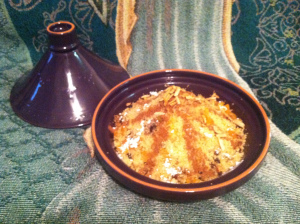A vegetarian taste of Morocco that's sure to delight (Vegetarian Tagines and Couscous)
- Bundtlust
- Jun 18, 2016
- 4 min read
Ghillie Basan, author of several cookbooks on Turkish and Middle Eastern cuisine including Classic Turkish Cooking and Tagines & Couscous: Delicious Recipes for Moroccan One-pot Cooking, offers up a vegetarian (mostly vegan) Moroccan feast in "Vegetarian Tagines & Couscous." Although at first glance this would appear to be a slim volume (65 recipes total), "Vegetarian Tagines & Couscous" is a wonderful all-in-one source for Moroccan pantry staples, light mezze and appetizers, creative ways to make the most of seasonal vegetables and produce, and wonderful couscous and fruit salads that are welcome any time of year. The ingredients and instructions are clearly laid out, and most ingredients should be readily available at your local supermarket. Most of the recipes can be easily made vegan by swapping out agave for honey, using olive oil in place of butter, or by omitting the cheese and eggs (there are relatively few recipes that call for either).
Beginning with essential recipes such as preserved lemons, smen, harissa, chermoula, and ras el hanout, the book offers a diverse selection of light appetizers including cracked green olives and cardamom and harissa, crudités with red chilli dukkah dip, filo fingers stuffed with feta, olives, and preserved lemon, smoked aubergine and yogurt dip with harissa, and strained yogurt and cucumber dip with rose petals. There are also several flavor-infused soups like creamy pumpkin soup with ginger and chilli honey and chilled almond and garlic soup.
The included tagines (both light and hearty) offer a wide range of preparations of vegetables and legumes including the wonderful tagine of artichokes, broad beans, apricots and almonds, onion, olive, and egg tagine with zahtar, and tagine of spicy roasted pumpkin wedges with lime. There are also a number of fruit tagines including the tagine of roasted pear with figs, walnuts and cardamom, stuffed prune tagine with walnuts and rosewater, and pumpkin, apple, and sultana tagine with chermoula, that are a wonderful way to braise fruit to a soft, creamy consistency. I enjoyed the stuffed prune tagine with its spiced wine reduction over Greek yogurt in the mornings!
The cooking instructions for the several couscous dishes yield a light, fluffy couscous unlike the "typical" American boxed couscous. True Moroccan couscous is made fresh and is slowly steamed and fluffed until light and airy. The couscous recipes here are a compromise between the two methods, yielding light, fluffy couscous without the long time steaming, fluffing, adding liquid and repeating. Ghillie has you first soak the couscous in warm water, then fluff the grains with a fork to separate, rub oil into the grains using your fingers, then aerate before baking to heat through. I attempted the couscous with dried fruit and nuts and it turned out every bit as beautiful (and delicious) as the cover photo! You'll also find the traditional couscous with seven vegetables as well as a saffron couscous with roasted coconut and pistachios, couscous with hot apricot chutney and halloumi (the recipe for the homemade chutney is worth the cost of the book alone!), and harissa couscous with pine nuts and fried eggs.
One important word of caution is that your type of tagine and stovetop may result in many of these being prepared in a dish other than a tagine as many of the tagines are cooked on the stovetop versus oven; I have a ceramic stovetop and two clay tagines and was advised not to use clay/terra cotta tagines even with a heat diffuser, so for the many stovetop preparations I used my 4.5-quart Staub Dutch oven instead. If you have a Staub or Le Creuset cast iron tagine, then you should be fine using them directly on a ceramic stovetop.
One of my favorite parts (and a wonderful way to close out a meal) is the gorgeous fruit salads; I made the orange and date salad with chillies and preserved lemon and grapefruit and pomegranate salad with rosewater (see photo); these quickly became favorites and I make them at least every other week now. They are easy to put together and the flavors work wonderfully together, not to mention the striking presentation (I like to fan out the orange segments into a star shape). The contrast between sweet and tart (the preserved lemons), or fruity and floral, serves to balance out spicier dishes or as an anytime treat. Several basic jams and pickle recipes are also included (tomato jam with cinnamon and roasted sesame seeds, lemon, coriander and mint jam, pickled pears with saffron and cinnamon, date relish, and pickled red chillies and purple turnips).
The book's graphic layout and photography by Steve Painter is also stunning, featuring vibrant piles of spices, silks, and gorgeous tilework interspersed throughout. There are full-page, full-color photos for nearly every finished dish.
I find myself turning to "Vegetarian Tagines & Couscous" frequently for the many creative, delicious takes on traditional Moroccan stews; there is plenty of variety to keep you experimenting happily for many weeks or months to come!
(review copy courtesy of Ryland Peters & Small)
















Comments